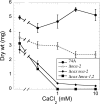Role of four calcium transport proteins, encoded by nca-1, nca-2, nca-3, and cax, in maintaining intracellular calcium levels in Neurospora crassa
- PMID: 21335528
- PMCID: PMC3127652
- DOI: 10.1128/EC.00239-10
Role of four calcium transport proteins, encoded by nca-1, nca-2, nca-3, and cax, in maintaining intracellular calcium levels in Neurospora crassa
Abstract
We have examined the distribution of calcium in Neurospora crassa and investigated the role of four predicted calcium transport proteins. The results of cell fractionation experiments showed 4% of cellular calcium in mitochondria, approximately 11% in a dense vacuolar fraction, 40% in an insoluble form that copurifies with microsomes, and 40% in a high-speed supernatant, presumably from large vacuoles that had broken. Strains lacking NCA-1, a SERCA-type Ca(2+)-ATPase, or NCA-3, a PMC-type Ca(2+)-ATPase, had no obvious defects in growth or distribution of calcium. A strain lacking NCA-2, which is also a PMC-type Ca(2+)-ATPase, grew slowly in normal medium and was unable to grow in high concentrations of calcium tolerated by the wild type. Furthermore, when grown in normal concentrations of calcium (0.68 mM), this strain accumulated 4- to 10-fold more calcium than other strains, elevated in all cell fractions. The data suggest that NCA-2 functions in the plasma membrane to pump calcium out of the cell. In this way, it resembles the PMC-type enzymes of animal cells, not the Pmc1p enzyme in Saccharomyces cerevisiae that resides in the vacuole. Strains lacking the cax gene, which encodes a Ca(2+)/H(+) exchange protein in vacuolar membranes, accumulate very little calcium in the dense vacuolar fraction but have normal levels of calcium in other fractions. The cax knockout strain has no other observable phenotypes. These data suggest that "the vacuole" is heterogeneous and that the dense vacuolar fraction contains an organelle that is dependent upon the CAX transporter for accumulation of calcium, while other components of the vacuolar system have multiple calcium transporters.
Figures







References
-
- Ashford A. E., Vesk P. A., Orlovich D. A., Markovina A. L., Allaway W. G. 1999. Dispersed polyphosphate in fungal vacuoles in Eucalyptus pilularis/Pisolithus tinctorius ectomycorrhizas. Fungal Genet. Biol. 28:21–33 - PubMed
-
- Benito B., Garciadeblas B., Rodriguez-Navarro A. 2000. Molecular cloning of the calcium and sodium ATPases in Neurospora crassa. Mol. Microbiol. 35:1079–1088 - PubMed
-
- Berridge M. J., Bootman M. D., Roderick H. L. 2003. Calcium signalling: dynamics, homeostasis and remodelling. Nat. Rev. Mol. Cell Biol. 4:517–529 - PubMed
-
- Bok J. W., et al. 2001. Structure and function analysis of the calcium-related gene spray in Neurospora crassa. Fungal Genet. Biol. 32:145–158 - PubMed
Publication types
MeSH terms
Substances
Grants and funding
LinkOut - more resources
Full Text Sources
Molecular Biology Databases
Miscellaneous

